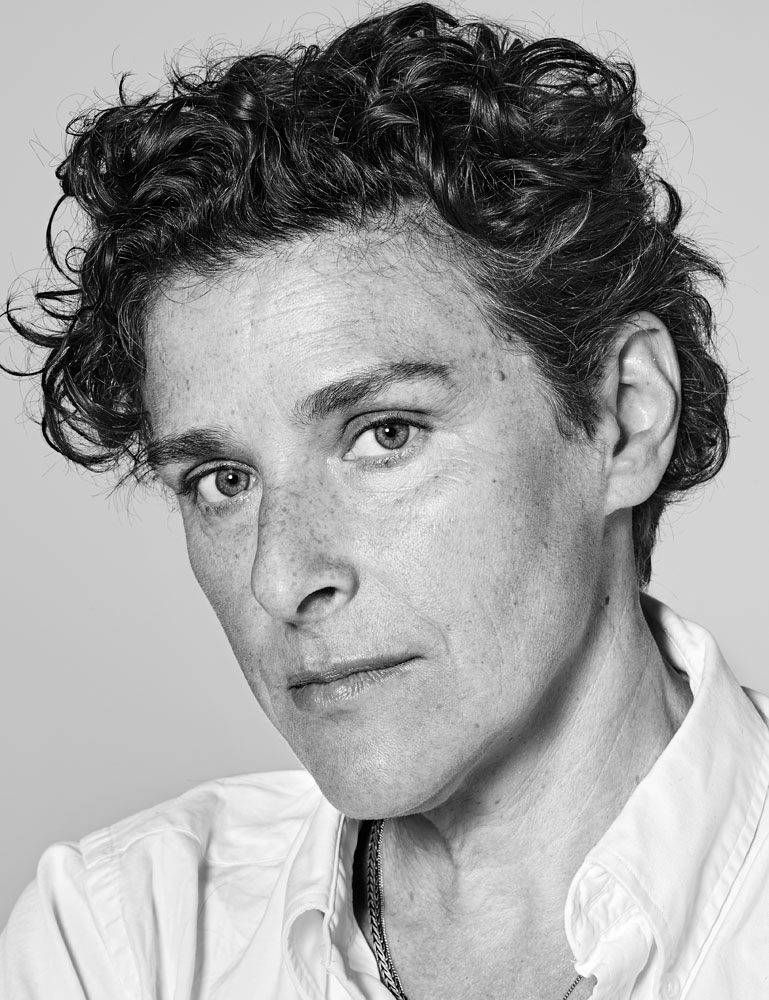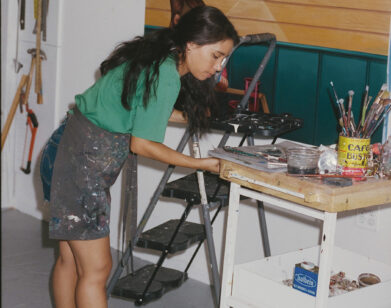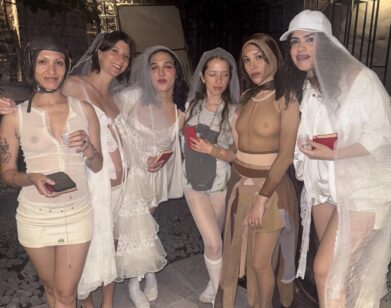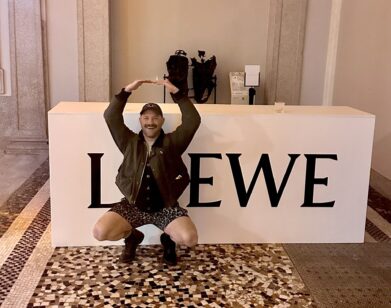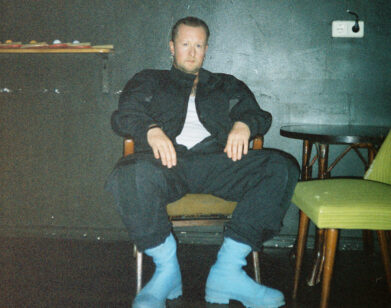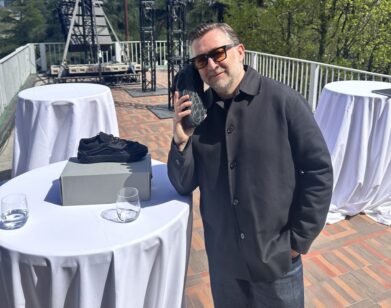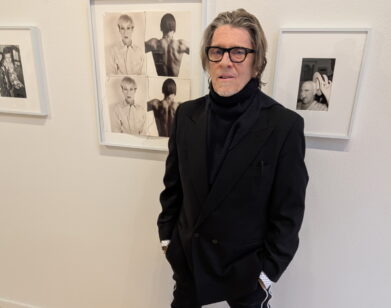Zoe Leonard
The far wall of Zoe Leonard’s Brooklyn Navy Yard studio is a grid of large, rectangular windows. The view is both banal (industrial buildings, cranes) and ethereal (summer haze, a sort of magical white light). The windows seem important, or at least appropriate, within the context of interviewing the artist. They are frames. They are portals for light. They are object and opening, container and substance. All of this puts me in mind of Leonard’s variable, vital work; each of her pieces offers a new window, a new view, a new—and often slightly subversive—way of looking at the world. Leonard—whose acclaimed work has been selected for not one but three Whitney Biennials—has been living and working in New York City for most of her adult life. Since she came onto the scene in the 1980s, she has seen the city shift and change around her, and has played a large part in shaping it herself—both through her activism and her art. In 1992, for documenta, she replaced the classical paintings of men in the Neue Galerie in Kassel, Germany, with her own up-close photographs of vaginas; her installation Strange Fruit (for David) (1992-97), in which she sewed up the skins of common fruit, was dedicated to artist David Wojnarowicz and is inseparable from her earlier work in AIDS activism. In 1998, she began an 11-year-long project in which she photographed liquidating storefronts and their past-prime merchandise in the Lower East Side; the resulting show “Analogue,” paints a portrait of a neighborhood in transition, but also hints at the tragedy of displacement, the cruelty of capitalism, and the ache of the useless. The series would go on to include blighted urban imagery worldwide.
Leonard’s works often capture these sorts of societal shifts and changes (perhaps this is an inevitability when one’s practice involves patient, long-term looking). Here she speaks to the “different city” that she inhabited in the late ’70s and early ’80s, the changing reality for working artists, and how her personal past and the political present are merging in her newest body of work (In the Wake, a series of photographs and sculptures which opens this month at New York’s Hauser & Wirth gallery). In conversation, as in her work, Leonard is extremely generous. She wants to give you something to take with you, a little piece of how she sees things. She wants to give you a vantage point, a window, through which you can gaze at the world with intention, and through which, if you look closely enough, you might see a changed place, an alternative, even an opportunity for justice.
MOLLY PRENTISS: Can you walk me through what’s happening in your studio right now? What is this current project you’re working on?
ZOE LEONARD: It’s a new body of work for the show in September. This stuff on the wall right now is probably what I would call the heart of the work. It is photographs of photographs of my mom’s family in the period of time before, during, and after the Second World War. They were Polish. My grandmother and great-aunt stayed and participated in the Resistance. A lot of them were killed and a few survived and had to get out of Poland, and then were basically stateless and displaced for over a decade, until they finally ended up here and naturalized. But there was a period of about 15 years where they were stateless. When I cleaned out my mom’s house after she passed, I found a suitcase of photographs. Some I recognized from my childhood, but a lot I’d never seen before. And I began to piece together the stories I’d heard as a child and understand them in relationship to these images. So I’ve been rephotographing these older photographs. I got interested maybe less in telling the precise story of my family and more in this condition of statelessness and displacement and the reverberation that it has down through generations. And I guess because of what we’ve all been reading about in the newspaper, it seemed like a telescoping of time where very similar things were happening in the past and present, and millions of people are actually out on these same shores looking for a place to live and be safe. So it gave an urgency to the project.
PRENTISS: What did it feel like to work with such personal documents? Is that different for you from the way you usually make art?
LEONARD: [laughs] Yeah. Really strange. I didn’t know if this would be something I’d show—you know, I’ve never really made autobiographical work. I’m in all of my work, and there’s nowhere to hide when you make work, but never so explicitly. I mean, I look like my grandmother … There’s a lot of psychological material that you inherit from your family. I guess what made it feel okay, or possible, for me is that every single human being, and certainly anyone in America, has inherited some form of this trajectory from their family. So it’s my story, and it’s personal, but it’s part of a human condition and part of a way that we inherit the displacements and the traumas of wars and the large social events that happen that are very real in your life even if you’re not there. They’re in the fabric of our being.
PRENTISS: You lived in downtown New York in the ’70s and ’80s. I feel like there’s this conversation happening right now about how cool and generative that time period was for artists, and the spaces that were able to exist then that aren’t able to now. What was your experience of that time?
LEONARD: It was such a different city. My God. I grew up in Harlem, but I moved to the Lower East Side when I was a teenager and it was … I feel like when I try to describe it, it doesn’t sound believable. It just sounds like you’re lying. And I see it on the faces of my younger friends. They’re going, “Uh huh, uh huh,” and you’re like, “No. No, really.” On the one hand, it was tragic and forlorn. Below 14th Street, everything was boarded up. There were whole blocks where maybe one building wouldn’t be boarded up. Massive amounts of drugs were being sold on the street. So in many ways, it was desolate and frightening and super violent and really crazy. But it also meant that you could have, as I did, a five-room apartment on Stanton and Ludlow for $220 a month, and you could, as a young artist, writer, whoever, come to New York and get a job as a coat-check girl or waiter. You could do some kind of minimal labor that would get your bills paid. In that way, you had time. So you had this amazing community that was willing to live on the edges and where money wasn’t really the currency. Like, who gave a shit, really? Nobody, as long as you had enough to eat and whatever. But as a 15-, 16-year-old, I started going to Max’s Kansas City, and then it was CBGBs. Then the Mudd Club opened, so I went there every night and saw so much incredible music. It felt much less segregated than now. It wasn’t like, “You’re in the art world.” I never heard the term “art world” until I was in my thirties, and I was like, “What are you guys talking about?” It’s the world, and we all live in the world! I would go to a poetry reading, I would go to an art opening, I would go to a loft party. You would end up at a film shoot. I really loved music and went to a lot of clubs to see bands and dance. I loved going out. It just felt like those lines weren’t so segregated and drawn. And the same in some ways with the straightness and queerness. I mean, there was a whole gay world that I got to know better later, but at a place like the Mudd Club, it was very polyamorous in a certain way.
PRENTISS: More fluid?
LEONARD: Much more fluid. And the questions weren’t like, “Are you rich? Are you poor? Are you queer? Are you straight?” It was more like, “Are you interesting? What are you thinking about? What do you make? How do you dance?” I was young, so it’s subjective, but it felt very different. I think some of that is an energy that came from the avant-garde, from the people making things. But some of it was about the economics of a place that could allow for that. I mean, a lot of the time I didn’t have a phone. We didn’t have cellphones. Somebody would get a phone but they’d have to get an answering machine. So your communication was more like, people would stop by your house, you would stop by their house, or you would run into people on the street. And most people who did theater, art, film lived below 23rd Street. Like, Squat Theater on West 23rd Street; that was as far north as you were even gonna go. Except, maybe once a year, to the Met or the Frick. But pretty much everything was downtown. So you walked everywhere, and you went to places, and you knew who would be there. It engendered something, a kind of community that allowed for me to develop as an artist without going to school. I dropped out of school when I was 15 or 16. When I teach, I see younger artists in their brilliant amazingness, and it’s really hard. They move here and have to make their rent, and it’s so expensive to have a studio. Because of that, there’s a pressure to have a career. And that really changes what you make and how you think. People also live much farther from each other. Some people move to Bushwick and some to Ridgewood and some to Red Hook and some to Washington Heights. So there’s not that boiling pot.
PRENTISS: I was just reading this Edmund White essay, where he talked about proximity. That’s why that moment was what it was. Now the pushing out into other neighborhoods basically diffuses the energy, at least the kind of explosiveness that comes with actually being around other people and running into them, literally.
LEONARD: Yeah, totally. I’m always amazed at how people make work no matter how intense the pressure. It seems like the margin, the avant-garde, keeps remaking itself and people find spaces and throw a party and open a little gallery—so much productive, sincere, curious, explosive, radical energy. I wouldn’t be here if I felt like that wasn’t here. But I think it’s just harder. It’s hard in a different way.
PRENTISS: You said you hadn’t even heard the term “art world” until much later in your life. Is there a moment in your life or your career where you started being like, “I’m an artist”?
LEONARD: Oh, God, “I’m an artist”? Yeah, that happened when I was like 14. It wasn’t a career; it was just a conviction or a knowing yourself. For a while, I thought maybe I was a writer because I always had a notebook and a camera.
PRENTISS: A documenter.
LEONARD: Yeah. You know, sitting up all night in a coffee shop writing in a notebook. One cup of coffee and one corn muffin. Make that last till five a.m.
PRENTISS: [laughs] That’s what I still do!
LEONARD: That’s how you wrote your book. So, yeah, the conviction. It wasn’t like an “I have to make it” feeling. It wasn’t an “I have to succeed” feeling; it was more like a “I have to make this right now.” Maybe it’s like this for a lot of artists and makers, writers, thinkers; it was how the world would make sense to me. And it always has been, even as a little kid. The experiences were made whole by reflecting on them. And that was a way of sharing it and making it whole for myself.
PRENTISS: The conversation that’s happening so much with my friends is: How do you figure out how you can live here, how you can make you work and carve out that time? Did you ever deal with that balance? Or because of the New York City scene, were you just on that track from the start?
LEONARD: Yeah, it has always been a balance in that I was really poor for most of my adult life. [laughs] And I was just able to be that way. I’d grown up poor; I had no idea what it was like to be comfortable. Now it’s still a struggle in other ways because I want to make the work that I want to make, so it’s also about keeping certain pressures at a distance too.
PRENTISS: As soon as it conflates with any sort of commerce—as soon as your art is affording you your life—there’s a weird dynamic that happens.
LEONARD: Yeah. It’s complicated. There’s that saying: “Don’t put the cart before the horse.” If the work is the horse, a career makes a great cart.
PRENTISS: That’s an amazing quote!
LEONARD: It’s a good thing to have and it can support your work, but don’t let that get in front. At least I can’t. The career has to support the making and can offer a platform, can offer you a voice in the world. And that’s an incredible thing. But it’s complicated and seductive and weird and tricky. I think you have to keep figuring that out your whole life.
PRENTISS: I like this thing I read about your “Analogue” show. A critic called it “marvelously plain.” I wondered what your relationship is to aesthetic simplicity or plainness or straightforwardness? When I look at your work, I see that, at least visually. Do you think there is something marvelous about being plain?
LEONARD: I do. I like getting stuff out of the way so you can see something clearly, see it sharply, have it be new again. And I think making things that appear simple is incredibly hard. By nature, I’m a little distractible. I get very overwhelmed by the world. I can just go, “Oooh, what’s that on the sidewalk? Oooh, look at the bird in the sky!” The world feels overwhelming to me on every level. Just the number of organisms that live on this planet. Our politics, our violence, psychology, emotions; there’s just a lot going on, right? And so something about photography is tied to a very specific relationship with the material world. It doesn’t have to be, but the way I practice it, it is. So there’s an act of observation, but it’s not an act of objective recording. It’s about framing something and seeing it and understanding that it’s relational. It’s how you’re looking as much as what you’re looking at. I can’t tell you how much material I generate. It’s ridiculous. Photographers talk about their shoot ratio. Like four to one, six to one, ten to one! Whatever, I’m, like, seven billion to one. It is just ridiculous. But sometimes if you can hit it just right and get everything out of the way, something will resonate on multiple levels.
PRENTISS: So editing is a huge part of the practice.
LEONARD: Huge. Editing, tweaking, going back. I identify with writers a lot in that process. I generate material and then go back and edit, and sometimes I have to reshoot. Making work for me is being in the world, but it’s also being specific about being in the world. I’m interested in this increasingly rare space of contemplation and taking the time and energy to be thoughtful. We’re all busy. It’s a very fast-paced world. And art—and by that, I mean culture in a wider sense—is one of the few spaces where we’re allowed to look and think without an immediate response or reaction.
PRENTISS: Totally. Do you find other overlaps with writing in terms of process? You helped to create the Fae Richards character [in the Fae Richards Photo Archive, 1993-96, 82 images that document the life story of the fictional black lesbian actress Fae Richards] and I started thinking about how you use character in your work and narrative and storytelling.
LEONARD: The Fae Richards piece is singular in my work, and it was a collaboration essentially. The filmmaker Cheryl Dunye wanted to make a film [The Watermelon Woman, 1996] that had this fictional character, and so she asked me to make a photographic archive of this person that had never existed so that she could make a movie about her. It came as, I wouldn’t say an assignment, but it came that way. Then it really took fire for me. I think Cheryl probably had something much more modest in mind, and I went nuts on it. Fae Richards was a chance to kind of embody and imagine these histories and stories that maybe hadn’t been told yet.
PRENTISS: Did you start to feel like you knew her?
LEONARD: Absolutely. We all did. That was a massive collaboration with Cheryl, and then friends who did costumes and made sets. It was a massive undertaking with no money whatsoever. I learned a lot. It’s been on my mind in a funny way with some of this new work because this is not fiction.
PRENTISS: I was thinking what an interesting difference it is. The new work is the opposite of fiction, but it’s still similarly this documentation that has holes …
LEONARD: Yes. It’s exactly that. It was about realizing how much I can’t know, how much more I want to know. There’s a way that these questions and ideas and situations feel alive and relevant today—to me personally in terms of understanding my inheritance, my own psychology, what I was taught nonverbally, what’s passed down inside a family. But beyond that, this whole social landscape that we share. I just settled on a title last week. The show is going to be called “In the Wake.” It’s that the main event in this case, the Second World War, is outside the frame, but the people in these photographs, they’re in that wake. They’re displaced and stateless, having had their lives changed by the violence of fascism. And then now I’m in the wake of that. And we’re also in the middle of something else now, and I don’t quite understand how a generation and a half after the Second World War we’ve gotten where we are now. I don’t understand why we’re not welcoming refugees into this country. I know it’s so complicated, all the different wars that we’re participating in or supporting or not supporting. But there’s something really frightening in this incredible move to the right. And the Brexit last week was a shock to all of us. After the First World War, it was, like, let’s form the League of Nations, we have to learn to work together. It’s the only way we’re going to survive. And now it’s like we’re undoing these very fragile institutions that were built after the First and Second World Wars that were about nations working on a kind of global diplomacy for our mutual benefit. And we’re undoing them at such rapid-fire pace. One of the other meanings of “In the Wake” is the idea of being awake. You need to have your eyes open because it’s really scary what’s happening. I don’t think any of us thought Trump could get this far. I don’t think anyone so blatantly racist and sexist with just no respect for working people—
PRENTISS: It seems like a joke, doesn’t it?
LEONARD: Yeah! But he’s gotten this far. He’s a presumptive nominee. It’s just wild! There’s a desire for me in the work, even when I’m looking at the past, to be looking from the present. It’s to be here now. It’s looking in the present tense.
PRENTISS: What is the most uncomfortable part of being an artist?
LEONARD: This.
PRENTISS: [laughs] I’m the most uncomfortable part?
LEONARD: Not you! This process.
PRENTISS: Why?
LEONARD: Because I made the work, and I’m honored and flattered that people want to talk about it. But I choose to work behind the camera. And I kind of want to make the work and then run away. The presentation of myself really feels complicated for me. If I could’ve, I’d have just given you a key and been like, “Go into the studio and interview the photographs. They’ll tell you!”
PRENTISS: What is the most joyful part of making art for you?
LEONARD: Oh wow. I love it so much. I think it’s amazing. I’ve been taking pictures since I was probably 16. I’m 54, and I can’t believe how excited I am. [laughs] I’ll finish a body of work and think, “Okay, I got nothing. That was it. I’m done.” And then you’ll turn a corner and be like [gasps], “Oh my God!” And it keeps happening. I feel so lucky. It’s so interesting, you know? I’m always learning. I can’t imagine doing anything else.
MOLLY PRENTISS IS A BROOKLYN-BASED AUTHOR. HER DEBUT NOVEL, TUESDAY NIGHTS IN 1980, WAS RELEASED IN APRIL.

